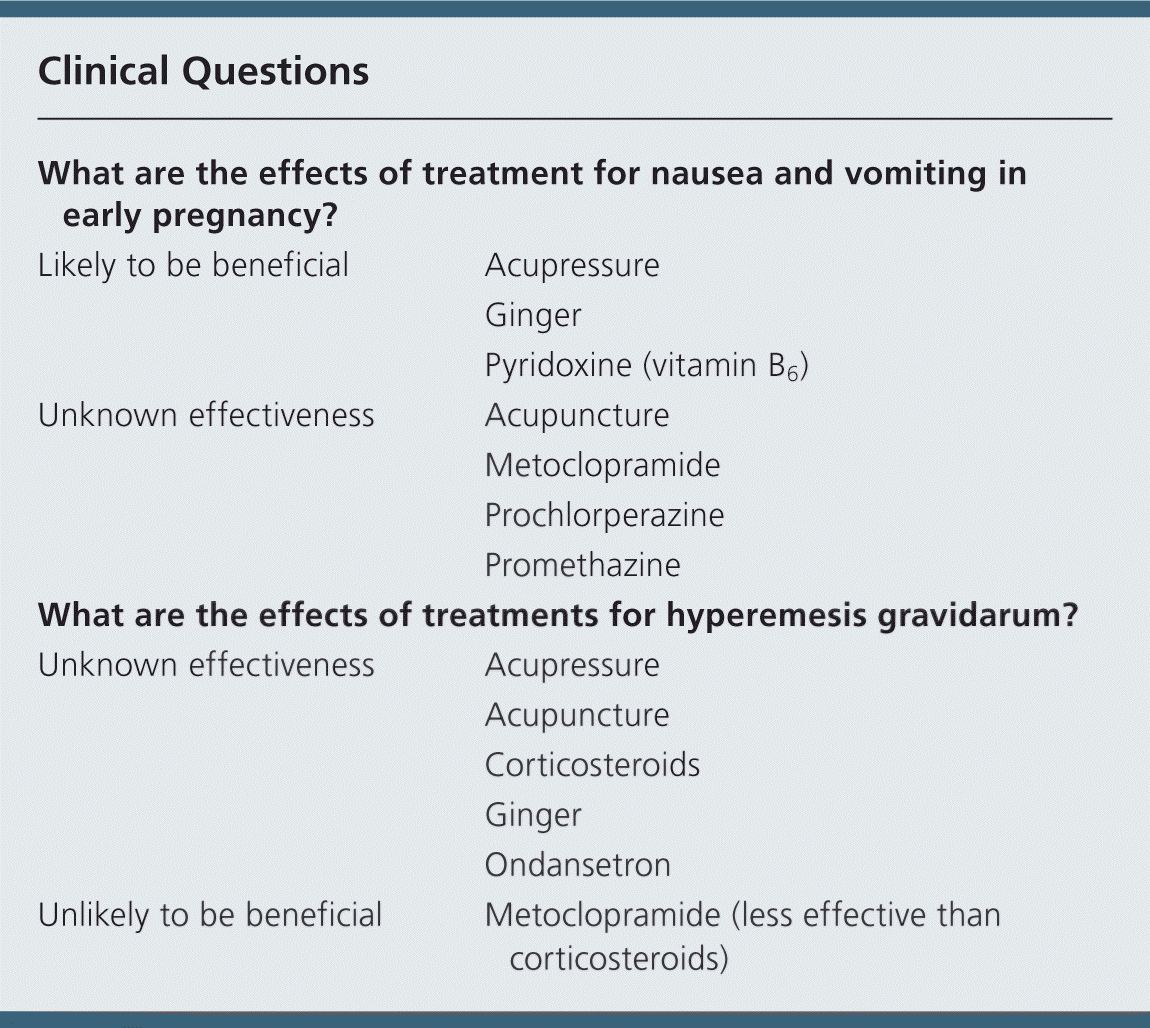
Am Fam Physician. 2015;92(6):516-517
Author disclosure: Mario Festin declares that he has no competing interests.
More than one-half of pregnant women have nausea and vomiting, which typically begins by the fourth week and disappears by the 16th week of pregnancy.
The cause of nausea and vomiting in pregnancy is unknown, but it may be due to the rise in human chorionic gonadotropin concentration.
In one out of 200 women, the condition progresses to hyperemesis gravidarum, which is characterized by prolonged and severe nausea and vomiting, dehydration, and weight loss.
In general, the trials we found were small and of limited quality. There is a need for other large high-quality trials on this condition with consistent outcomes.
For nausea and vomiting in early pregnancy:
Ginger may reduce nausea and vomiting compared with placebo, although studies used different preparations of ginger and reported varying outcome measures.
Pyridoxine (vitamin B6) may be more effective than placebo at reducing nausea, but we do not know about vomiting, and evidence was weak.
Pyridoxine may be as effective as ginger at reducing nausea and vomiting, although evidence was limited.
Acupressure may be more effective than sham acupressure at reducing nausea and vomiting. However, evidence was weak, and interventions and outcomes varied between trials.
We do not know if acupressure is more effective than pyridoxine at reducing nausea or vomiting because we found insufficient evidence.
We do not know if acupuncture is more effective than sham acupuncture at reducing nausea and vomiting.
We do not know if prochlorperazine, promethazine, or metoclopramide reduces nausea or vomiting compared with placebo.
For hyperemesis gravidarum:
We do not know if acupressure, acupuncture, corticosteroids, ginger, metoclopramide, or ondansetron is effective at treating hyperemesis gravidarum.
Hydrocortisone may be more effective than metoclopramide at reducing vomiting episodes and reducing readmission to the intensive care unit in women with hyperemesis gravidarum.

| What are the effects of treatment for nausea and vomiting in early pregnancy? | |
|
|
|
|
| What are the effects of treatments for hyperemesis gravidarum? | |
|
|
|
|
Definition
Nausea and vomiting are common problems in early pregnancy. Although often called morning sickness, nausea and vomiting can occur at any time of day and may persist throughout the day. Symptoms usually begin between four and seven weeks' gestation (one study found this to be the case in 70% of affected women), and they disappear by 16 weeks' gestation in about 90% of women. One study found that less than 10% of affected women have nausea, vomiting, or both before the first missed period.
Most women do not require treatment and complete the pregnancy without any special intervention. However, if nausea and vomiting are severe and persistent, the condition can progress to hyperemesis, especially if the woman is unable to maintain adequate hydration, fluid and electrolyte balance, and nutrition. Hyperemesis gravidarum is a diagnosis of exclusion, characterized by prolonged and severe nausea and vomiting, dehydration, and weight loss. Laboratory investigation may show ketosis, hyponatremia, hypokalemia, hypouricemia, metabolic hypochloremic alkalosis, and ketonuria.
Incidence and Prevalence
Nausea affects about 70%, and vomiting about 60%, of pregnant women. The true incidence of hyperemesis gravidarum is unknown. It has been documented to range from three to 20 in 1,000 pregnancies. However, most authors report an incidence of one in 200.
Etiology
The causes of nausea and vomiting in pregnancy are unknown. The theory that they are caused by a rise in human chorionic gonadotropin concentration is compatible with the natural history of the condition, its severity in pregnancies affected by hydatidiform mole, and its good prognosis (see Prognosis). The cause of hyperemesis gravidarum is also uncertain. Endocrine and psychological factors are suspected, but evidence is inconclusive. Female fetal sex has been found to be a clinical indicator of hyperemesis. One prospective study found that Helicobacter pylori infection was more common in pregnant women with hyperemesis gravidarum than in pregnant women without it (95 out of 105 women [91%] with hyperemesis gravidarum had positive H. pylori immunoglobulin G concentrations compared with 60 out of 129 women [47%] without hyperemesis gravidarum). However, it was not clear whether this link was causal.
Prognosis
One systematic review found that nausea and vomiting were associated with a reduced risk of miscarriage (six studies, 14,564 women; odds ratio = 0.36; 95% confidence interval, 0.32 to 0.42) but found no association with perinatal mortality. Hyperemesis gravidarum is thought by some to induce nutrient partitioning in favor of the fetus, which could explain the association with improved outcome in the fetus. Nausea and vomiting and hyperemesis usually improve over the course of pregnancy, but in one cross-sectional observational study, 13% of women reported that nausea and vomiting persisted beyond 20 weeks' gestation. Although death from nausea and vomiting during pregnancy is rare, morbidities, including Wernicke encephalopathy, splenic avulsion, esophageal rupture, pneumothorax, and acute tubular necrosis, have been reported.
search date: September 2013
Adapted with permission from Festin M. Nausea and vomiting in early pregnancy. Clin Evid Handbook.
